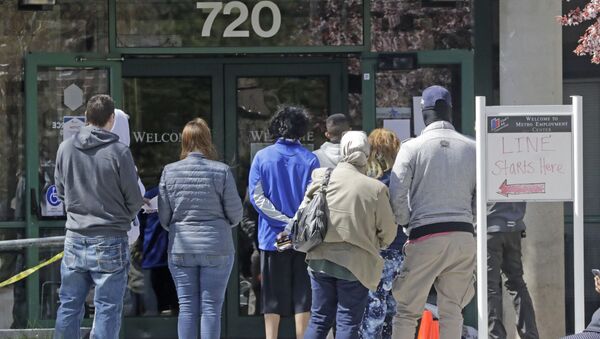A disproportionately larger proportion of the roughly 36 million workers who lost their jobs over the past two months have been women, Hannah Dickinson, an associate professor at Hobart and William Smith Colleges and an organizer with the Geneva Women’s Assembly, and Nathalie Hrizi, an educator and political activist and the editor of Breaking the Chains magazine, told Radio Sputnik’s Loud and Clear.
“Over the last couple weeks, the Bureau of Labor Statistics (BLS) reported April job numbers, and so we’ve been paying really close attention to this, because we know that there were 20.5 million jobs lost in April. So that’s an enormous number, and women accounted for 55% of those lost jobs. So, 55% might sound kind of like half but it’s not … It’s a significantly higher proportion of those people being women,” Dickinson told host Brian Becker and show producer Nicole Roussell.
According to the BLS Economic News Release published on May 8, the unemployment rate was 13% for men and 15.5% for women. In general, “unemployment rates rose sharply among all major worker groups.” The Labor Department last Thursday reported that workers had filed nearly 3 million new unemployment claims in just the preceding week amid the COVID-19 pandemic.
The rise in unemployment among women “represents a significant reversal of job gains that women had seen over the last several years,” Dickinson revealed.
“So, we covered in December, actually, a story about how December was the first time that there were more women employed in the workforce than men, and coronavirus has dramatically changed that trajectory … The problem is really compounded for single mothers, for black and Hispanic women and for women who work in sectors that are likely to force them into part-time work of fewer hours than they need to survive,” Dickinson explained.
A report published by the Wall Street Journal in January revealed that women had overtaken men “to hold the majority of US jobs for the first time in a decade.” Labor Department data shows that in December 2019, women held 50.04% of American jobs.
“What this unemployment rate means for women - because women, as we’ve talked about before, really bear a lot of what we’ve called the reproductive labor, or the responsibilities for undervalued or unpaid work that keeps things going, and the rate of unemployment for single mothers has more than tripled since February - that means that more than 1 million single mothers have become unemployed,” Hrizi pointed out.
“That’s huge to really think about what that means for women and for the families they are responsible for. Women tend to be in positions for caring for elderly family members or those who need additional care for whatever reason. So, the ripple effect of this is great,” she said.



